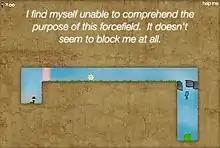The Company of Myself
The Company of Myself is a 2009 Flash platformer by Eli Piilonen featuring a hermit as the protagonist whose depressed inner thoughts appears as writing on the "walls" of the game.[1] Piilonen has stated that the "core intent [of the game] is to be half puzzle game and half character study".[2] It's been frequently cited as an early example of an art game and has received praise for how it deals with issues of mental health.[3][4][5][6] Tom Fronczak of Destructoid called the game "brilliant".[1] It was included in Michael Rose's 2014 book "250 Indie Games You Must Play"[7] and has been frequently cited in video games research.[8][9][10][11][12][13] Piilonen later released a prequel for the game called Fixation.
| The Company of Myself | |
|---|---|
 Screenshot of the game | |
| Developer(s) | Eli Piilonen |
| Platform(s) | Browser, Flash |
| Release | 2010 |
| Genre(s) | Puzzle platformer |
| Mode(s) | Single-player |
References
- "Monday Mind Teaser: The Company of Myself". Destructoid. 27 April 2010. Retrieved 7 August 2021.
- "The Company of Myself". 2darray.net. Retrieved 7 August 2021.
- Salter, Anastasia (2014). Flash: building the interactive web. Cambridge, Massachusetts. pp. 108–109. ISBN 9780262028028.
{{cite book}}: CS1 maint: location missing publisher (link) - "A medley of meanings: Insights from an instance of gameplay in League of Legends". Journal of Comparative Research in Anthropology and Sociology (1/2015): 228.
- "These Games Explore the Struggle to Seek Psychological Help". www.vice.com. 16 August 2016.
- Childs, Mark; Peachey, Anna (2013). Understanding learning in virtual worlds. London. p. 11. ISBN 9781447153702.
{{cite book}}: CS1 maint: location missing publisher (link) - Rose, Mike (2011). 250 indie games you must play. Boca Raton, FL. p. 162. ISBN 9781439875759.
{{cite book}}: CS1 maint: location missing publisher (link) - Demi̇Rbaş, Kerem Yavuz (6 August 2015). "DİJİTAL OYUNLARA "OYUN TÜRÜ" YAKLAŞIMLARININ SORUNLARI: "PLATFORM OYUNLARI" TÜRÜ ÖRNEĞİ". SELÇUK ÜNİVERSİTESİ İLETİŞİM FAKÜLTESİ AKADEMİK DERGİSİ. 9 (1): 363. doi:10.18094/si.05694.
- Orsini Martinelli, Felipe; Armando Valente, Jose. Os Jogos Digitais Vistos Pelo Jogador: análise de aspectos narrativos (PDF). SBGames Proceedings of SBC (ISSN 2179-2259). Retrieved 21 July 2021.
- Andersen, Erik; O'Rourke, Eleanor; Liu, Yun-En; Snider, Richard; Lowdermilk, Jeffrey; Truong, David; Cooper, Seth; Popovic, Zoran (2012). "The Impact of Tutorials on Games of Varying Complexity". Proceedings of the SIGCHI Conference on Human Factors in Computing Systems. Department of Computer Science & Engineering, University of Washington. pp. 59–68. doi:10.1145/2207676.2207687. ISBN 9781450310154. S2CID 2524148.
- Eurídice Cabañes, Eurídice; Rubio Méndez, María. "IDENTITY AND SIMULACRUM: THANK YOU MARIO, BUT YOUR IDENTITY IS IN ANOTHER CASTLE".
- Adellin, Riannatta; Khuan, Chen Tet; Gertrude, Leo David (2019). "Conceptual Framework Puzzle Game with High Replayability". Journal of Physics: Conference Series. 1228 (1): 012070. Bibcode:2019JPhCS1228a2070A. doi:10.1088/1742-6596/1228/1/012070.
- Marinescu Nenciu, Alina Petra; Rughinis, Cosima (2015). "Every Day the Same Dream? Social Critique Through Serious Gameplay". 11th International Conference eLearning and Software for Education. Vol. 2. Bucharest. pp. 65–72. doi:10.12753/2066-026x-15-100. S2CID 257196140.
{{cite book}}: CS1 maint: location missing publisher (link)
This article is issued from Wikipedia. The text is licensed under Creative Commons - Attribution - Sharealike. Additional terms may apply for the media files.